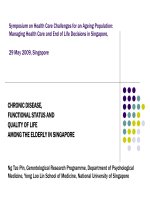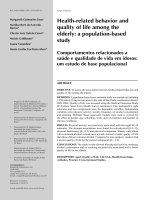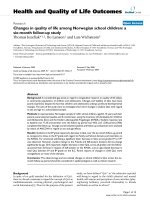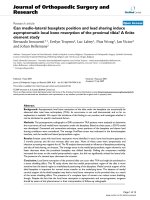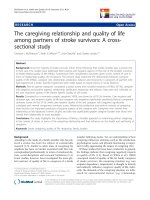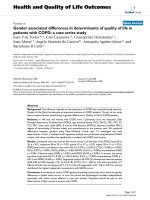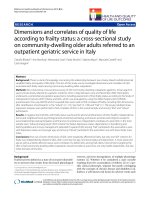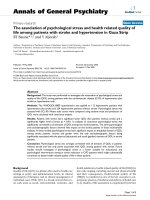Classifying and characterizing the development of self-reported overall quality of life among the Chinese elderly: A twelve-year longitudinal study
Bạn đang xem bản rút gọn của tài liệu. Xem và tải ngay bản đầy đủ của tài liệu tại đây (1.25 MB, 11 trang )
(2022) 22:1139
Huang et al. BMC Public Health
/>
Open Access
RESEARCH
Classifying and characterizing
the development of self‑reported overall quality
of life among the Chinese elderly: a twelve‑year
longitudinal study
Xitong Huang1, Minqiang Zhang1,2,3,4*, Junyan Fang1, Qing Zeng1, Jinqing Wang1 and Jia Li1
Abstract
Background: To promote healthy aging, the information about the development of quality of life (QoL) is of great
importance. However, the explorations of the heterogeneity in the change of QoL under the Chinese context were
limited. This study aimed to identify potential different development patterns of QoL and the influential factors using
a longitudinal, nationally representative sample of the Chinese elderly.
Methods: We adopted a five-wave longitudinal dataset from the Chinese Longitudinal Healthy Longevity Survey
(CLHLS), and a total of 1645 elderly were obtained. The sample had a mean age of 72.7 years (SD = 6.64) and was
47.2% male. Overall QoL was measured through self-report during the longitudinal process. We utilized the conditional growth mixture model (GMM) with time-invariant covariates (TICs) to explore various development patterns
and associated factors.
Results: Three distinct trajectories of self-reported overall QoL were identified: the High-level Steady Group (17.08%),
the Mid-level Steady Group (63.10%), and the Low-level Growth Group (19.82%). Results also indicated that several
factors predicted distinct trajectories of self-reported overall QoL. Those elderly who received enough financial
resources, had adequate nutrition, did not exhibit any disability, engaged in leisure activities, and did less physical
labor or housework at the baseline were more likely to report a higher level of overall QoL over time.
Conclusions: There existed three development patterns of self-reported overall QoL in elders, and the findings provided valuable implications for the maintenance and improvement of QoL among the Chinese elderly. Future studies
could examine the influence of other confounding factors.
Keywords: Chinese elderly, Chinese longitudinal healthy longevity survey, Self-reported overall quality of life, Growth
mixture model
*Correspondence:
1
School of Psychology, South China Normal University, West of Zhongshan
Avenue, Tianhe District, Guangzhou City 510631, Guangdong Province, China
Full list of author information is available at the end of the article
Introduction
Population aging is occurring worldwide. It is predicted
that the proportion of people aged 60 and above will be
as high as 22% in the global population by 2050 [1, 2]. The
accelerating of the aging process had aroused attention
all over the world and the life situation of old people has
sparked considerable scientific interest [1]. According to
the Statistical Bulletin on National Economic and Social
© The Author(s) 2022. Open Access This article is licensed under a Creative Commons Attribution 4.0 International License, which
permits use, sharing, adaptation, distribution and reproduction in any medium or format, as long as you give appropriate credit to the
original author(s) and the source, provide a link to the Creative Commons licence, and indicate if changes were made. The images or
other third party material in this article are included in the article’s Creative Commons licence, unless indicated otherwise in a credit line
to the material. If material is not included in the article’s Creative Commons licence and your intended use is not permitted by statutory
regulation or exceeds the permitted use, you will need to obtain permission directly from the copyright holder. To view a copy of this
licence, visit http://creativecommons.org/licenses/by/4.0/. The Creative Commons Public Domain Dedication waiver (http://creativeco
mmons.org/publicdomain/zero/1.0/) applies to the data made available in this article, unless otherwise stated in a credit line to the data.
Huang et al. BMC Public Health
(2022) 22:1139
Development in 2018 [3], the proportion of elderly who
aged above 60 reached 17.9% in the Chinese population,
with the number at 249 million. Thus, the issue of healthy
aging in China is worthy of attention [4–6].
One of the key factors that contribute to healthy aging
is a high level of quality of life (QoL) [1, 7]. QoL is typically defined as an individual’s general perception of
their position in life, which encompasses feelings of personal well-being, satisfaction with life, and self-worth
[7, 8]. The academic interest in older people’s QoL has
increased recently [7, 9]. QoL has been widely used as a
health-related outcome in research about diseases, like
dementia [10], cancer [11], and insomnia [12]. Besides,
the level of QoL was found to be associated with various
socio-demographic, health-related, and lifestyle factors,
like smoking status [13], wealth status [8], physical status
[10], and nutritional status [11].
To promote healthy aging, a full picture of QoL among
the elderly is warranted. Up to now, the longitudinal
explorations of QoL among the elderly have been largely
limited to the developed world [8, 14–16], and only a few
research focused on the Chinese population. Researchers identified five distinct change trajectories of QoL in
a large and heterogeneous sample of older New Zealanders, which demonstrated that improving, maintaining,
and declining QoL was possible to exist in later life simultaneously [17]. Evidence also suggested that there might
exist considerable heterogeneity during the development of QoL in the Chinese old population [9], while the
consensus about the classification results has not been
reached. For example, scholars recognized a consistent
tendency of increasing QoL among people with different
cognitive statuses [18], while another study argued that
the development of QoL might take on two kinds of trajectories by making an analogy to health well-being [19].
These inconsistent results warrant further exploration of
the heterogeneity in the change of QoL under the Chinese context. Moreover, the exploration of influencing
factors of QoL has been very limited in previous studies,
thus, different protective or risk factors are also worthy of
attention.
Considering that the classification approaches used
in previous studies among the Chinese population were
more in line with an artificial perspective or an analogical
perspective, the present study intends to use a powerful
analytic technique, the Growth Mixture Model (GMM)
[20] to identify the heterogeneity during the change process. The main advantage of GMM is that it doesn’t rely
on the assumption that all participants are drawn from
a single population, which is the limitation of the traditional longitudinal model like the Latent Growth Model
[21]. GMM aims to explain longitudinal heterogeneity
through the identification of unobserved sub-populations
Page 2 of 11
in the sample under research [20, 22]. In GMM, longitudinal heterogeneity is captured by the inclusion of a categorical latent variable that identifies potential different
development patterns, and the probabilities of classification for each individual are estimated to avoid the subjectivity of artificial grouping [20, 22, 23]. Furthermore,
several covariates can be included in the GMM, which
is called the conditional GMM, to identify the factors
affecting these development patterns [22, 23].
The current study aims to identify potential distinct
trajectories of QoL and the influential factors of the trajectory membership among the Chinese old population
using the conditional GMM. To our knowledge, this is
the first study to present the potential growth patterns of
QoL and the influential factors under the Chinese context from the person-centered viewpoint. By identifying
the underlying trajectories that had not been recognized
before, our findings could advance the understanding of
how QoL changes in different people, besides, exploring
the influencing factors during the development process
of QoL could provide insights for health researchers and
policymakers so that early interventions can be taken to
promote the QoL and improve the caring of the Chinese
elderly. The following two questions will be addressed:
1)Are there potential distinct trajectories of QoL
among the Chinese elderly individuals? What are the
characteristics of these trajectories?
2) Which specific factors affect the trajectory membership? Are these effects positive or negative?
Methods
Study design and sample
The data we used were from the Chinese Longitudinal
Healthy Longevity Survey (CLHLS), a collaborative effort
between Duke University in the United States and Peking
University in China. With the emphasis on the oldest-old
from 22 provinces in mainland China, the CLHLS collected face-to-face interviews with the elderly in 1998,
2000, 2002, 2005, 2008, 2011, and 2014 [24]. The CLHLS
interviewed all centenarians in the sampled provinces,
and various sources whenever available were used to
validate the accuracy of their age, including the birth certificate, genealogical documents, and household booklets [24]. The CLHLS collected data using internationally
compatible questionnaires administered by trained investigators. All participants provided informed consent
forms [24–26].
For this study, we used the surveys from 2002 to 2014,
which consisted of a five-wave dataset. The original
sample of 16,064 individuals was interviewed in 2002
(T1), and participants were excluded if they died, lost to
Huang et al. BMC Public Health
(2022) 22:1139
follow up, or failed to report on the index of self-reported
overall QoL. Ultimately, a total of 1645 of the 2002 initial interviewees who were re-interviewed in 2014 were
included. Figure 1 illustrated the structure of the analytic
sample included in this study and the reasons for dropout
in each measurement wave. The sample analyzed here
had a similar sex ratio (47.2% male) to those participants
who were excluded (42.1% male), and the proportions of
Han ethnic were also very similar (92.8, 94.6%). Our sample was slightly younger (mean age at T1 was 72.7) than
the excluded individuals (mean age at T1 was 87.9). The
average scores of self-reported overall QoL at T1 were
similar between our sample (3.67) and the excluded participants (3.66).
Measures
Self‑reported overall quality of life (QoL)
QoL is thought to encompass several aspects of life, like
emotional functioning, cognitive functioning, social
functioning, and spiritual well-being [27], but scholars
agreed that a one-dimensional measure was adequate to
represent it [28]. Measuring QoL with a single item has
proven to be psychometrically sound to provide a global
view of an individual’s QoL which refers to the overall
QoL [27, 29]. The single-item scale of overall QoL has
been widely used in empirical studies [30, 31]. Similar
to previous studies, the CLHLS adopted a single item
to measure overall QoL, which asked the participants to
report their feeling about overall life quality with a Likert
Fig. 1 Structure of the analytic sample
Page 3 of 11
scale: “very good (1)”, “good (2)”, “so so (3)”, “bad (4)”, “very
bad (5)”. To ensure a better understanding, this research
reversely treats the score as “very bad (1)” to “very good
(5)”, thus, a higher score represented a higher level of selfreported overall QoL.
Covariates
Several time-invariant covariates (TICs) were considered, which have been recognized as important to the
elder’s QoL in previous studies [10, 11, 13]. All covariates
were collected in 2002, the first wave of data collection,
which included 6 basic variables (age, gender - “male
= 1, female = 0”; ethnicity - “Han = 1, non-Han = 0”;
financial source - “enough = 1, not enough = 0”; smoking status - “current smoker = 1, not current smoker =
0”; drinking status - “current drinker = 1, not current
drinker = 0”), 5 dietary variables (eat fresh fruit, eat
meat, eat fish, eat egg, drink tea), 6 functional variables
(bathing disability, dressing disability, toileting disability,
transferring disability, continence disability, feeding disability) and 5 behavioral variables (do physical labor regularly, do housework, read newspapers/books, watch TV
or listen to the radio, take part in some social activities).
All the dietary, functional, and behavioral variables were
coded as 1 for “yes” and 0 for “never”.
Analysis
Rates of missing data were generally 1.87% for selfreported overall QoL and 0.03% for TICs. Multiple
Huang et al. BMC Public Health
(2022) 22:1139
imputations were used to handle missing data with five
imputed datasets.
Figure 2 presents the structural model of the conditional GMM using self-reported overall QoL as an illustration. All TICs mentioned above were included in the
conditional GMM. In the analyses model, means of intercepts and slopes were allowed to vary between classes
and within classes [32].
A series of GMMs of 1–4 classes were estimated to
distinguish different trajectories of self-reported overall
QoL among elderly individuals. Each k-class model was
compared to a k-1 class model, and several indices were
used to select the most optimal model, including the
Akaike’s Information Criterion (AIC), Bayesian Information Criterion (BIC), Sample-size Adjusted Bayesian
Information Criterion (SABIC), Entropy, Lo-MendellRubin likelihood ratio test (Lo-Mendell-Rubin LRT),
and Lo-Mendell-Rubin Adjusted Likelihood Ratio Test
(Lo-Mendell-Rubin Adjusted LRT). Lower AIC, BIC, and
SABIC values are indicative of better model fit. Significant LRT tests favor the k class model over the k-1 class
model. Higher entropy indicates greater model fit. Once
the optimal model was selected, TICs were entered into
the model as predictors of the latent class membership
(see Fig. 2).
Fig. 2 Structural model of the conditional GMM
Page 4 of 11
Multiple imputations and descriptive statistics were
calculated using SPSS 24.0 [33]. All GMMs were estimated using the Mplus 8.0 [34] with the Full-Information
Maximum Likelihood (FIML) estimation.
Results
Descriptive statistics
Descriptive statistics for the self-reported overall QoL
measured from 2002 to 2014 are presented in Table 1.
Over the 12 years, the average scores of self-reported
overall QoL gradually increased from 3.67 (SD = 0.81) to
3.80 (SD = 0.83).
Table 1 also presents the descriptive statistics of all the
22 covariates at the baseline. As can be seen, the mean
age of the elderly individuals was 72.73 (SD = 6.64), and
more than half of them were female. Most of the elderly
were of Han ethnic background and reported to have
enough financial resources. Nearly one-quarter of the
elderly did not smoke or drink alcohol at the baseline.
Meat and eggs were the most favorite food, and they
were eaten by more than 80% of the elderly participants.
Almost all the elderly did not exhibit any functional disability. The elderly individuals who reported doing physical labor regularly took up more than 80% of the sample,
Huang et al. BMC Public Health
(2022) 22:1139
Page 5 of 11
Mean (SD)
the same for the elderly who did housework, watched TV,
or listened to the radio during leisure time.
self-reported overall QoL (2002)
3.67(0.81)
Conditional GMM with covariates
Fitting result
self-reported overall QoL (2005)
3.67(0.81)
self-reported overall QoL (2008)
3.68(0.80)
self-reported overall QoL (2011)
3.74(0.87)
self-reported overall QoL (2014)
3.80(0.83)
Table 1 Descriptive statistics for the analyzed variables
Analyzed Variables
Focal variables
Eat fresh fruit
0.79(0.41)
Eat meat
0.85(0.36)
Eat fish
0.74(0.44)
Eat eggs
0.86(0.35)
Drink tea
0.53(0.50)
Table 2 presents the fitting results of several models. As
can be seen, the AIC, BIC, and SABIC had no agreement on which model fitted better. The entropy value
of the 3-class solution was the largest among the solutions, which meant that the best solution was probably
the 3-class solution. Additionally, both the Lo-MendellRubin LRT and Lo-Mendell-Rubin Adjusted LRT showed
that the 2-class solution fitted better than the 1-class
solution (p < 0.001), the 3-class solution fitted better than
the 2-class solution (p < 0.05) and the 4-class solution fitted better than the 3-class solution (p < 0.001). This suggested that the best solution contained at least 4 classes.
However, the interpretability of the 4-class solution was
limited because two of the four classes had a similar
change pattern. For the sake of parsimony, we chose the
3-class solution finally after considering the performance
of all indicators comprehensively.
Bathing disability
0.03(0.17)
Three‑class GMM
Dressing disability
0.01(0.09)
Toileting disability
0.01(0.08)
Transferring disability
0.00(0.07)
Continence disability
0.00(0.06)
Feeding disability
0.00(0.07)
Figure 3 presents the development trends of self-reported
overall QoL in the 3-class solution. The total number of
participants in the first group was 281, which accounted
for 17.08% of the sample. The first group had a high initial
level and a steady trend of self-reported overall QoL, with
the mean of the intercept being 4.07 (SE = 0.04, p < 0.001)
and the mean of the linear slope being 0.02 (SE = 0.01,
p > 0.05). Therefore, this group was labeled as the Highlevel Steady Group.
The second group (n =
1038) which accounted for
63.10% of the sample showed a medium initial level and
a steady trend. The mean of intercept was 3.74 (SE = 0.11,
p < 0.001) and the mean of the linear slope was 0.00
(SE = 0.02, p > 0.05), therefore, this group was named the
Mid-level Steady Group.
Basic variables (2002)
Age
72.73(6.64)
Gender, male
0.47(0.50)
Ethnicity, Han
0.93(0.26)
Financial resources, enough
0.81(0.39)
Smoking status, current smoker
0.25(0.43)
Drinking status, current drinker
0.25(0.43)
Dietary variables (2002)
Functional variables (2002)
Behavioral variables (2002)
Do physical labor regularly
0.85(0.35)
Do housework
0.87(0.34)
Read newspapers/books
0.27(0.45)
Watch TV or listen to the radio
0.84(0.37)
Take part in some social activities
0.21(0.41)
Table 2 Fitted indices for GMMs with 1 to 4 classes
Number of
Classes
AIC
BIC
SABIC
Entropy
Lo-Mendell-Rubin LRT
1
19,643.55
19,697.61
19,665.84
–
–
–
2
19,324.69
19,513.88
19,402.69
0.65
vs 1 35.81***
vs 1 366.88***
3
19,238.99
19,563.32
19,372.71
0.89
vs 2 246.73*
vs 2 223.99*
0.85
***
vs 3 48.82***
4
19,235.89
19,695.36
19,425.33
vs 3 49.01
Lo-MendellRubin Adjusted
LRT
AIC Akaike’s Information Criterion, BIC Bayesian Information Criterion, SABIC Sample-size Adjusted Bayesian Information Criterion, Lo-Mendell-Rubin LRT Lo-MendellRubin likelihood ratio test, Lo-Mendell-Rubin Adjusted LRT Lo-Mendell-Rubin Adjusted Likelihood Ratio Test
*
p < 0.05
**
p < 0.01
***
p < 0.001
Huang et al. BMC Public Health
(2022) 22:1139
Page 6 of 11
Fig. 3 Development trends of self-reported overall QoL
The third group (n = 326) accounted for 19.82% of the
sample, and it presented a low initial level and an increasing trend. In the third group, the mean of intercept was
2.99 (SE = 0.05, p < 0.001) and the mean of the linear
slope was 0.14 (SE = 0.03, p < 0.001), therefore, this group
was labeled as the Low-level Growth Group.
The impact of covariates
After identifying the development trends of self-reported
overall QoL, influential factors of these different trajectories were examined. In this study, we considered 6 basic
variables, 5 dietary variables, 6 functional variables, and
5 behavioral variables. These covariates were included in
the GMM as TICs, which were all collected at the baseline (in 2002). The Low-level Growth Group was used as
the reference group. Table 3 presents the effects of these
covariates in the 3-class solution.
It was found that men had higher odds of reporting a high level of overall QoL over time than women
(OR = 2.84, 95% CI: 2.02–3.98, p < 0.001 for the Highlevel Steady Group), those who had Han ethnic background were more likely to report a high level of overall
QoL constantly (OR = 3.21, 95% CI: 1.44–7.16, p < 0.01
for the High-level Steady Group), and the odds of reporting a higher level of overall QoL over time were significantly higher for those who received enough financial
sources (OR = 1103.03, 95% CI: 152.00–8004.62, p < 0.001
for the High-level Steady Group; OR = 81.25, 95% CI:
54.68–120.74, p < 0.001 for the Mid-level Steady Group).
Concerning the dietary factors, our results showed
that those who ate fresh fruit were related to higher
odds of reporting a higher level of overall QoL over
time (OR = 23.31, 95% CI: 12.82–42.37, p < 0.001 for the
High-level Steady Group; OR = 6.30, 95% CI: 4.78–8.30,
p < 0.001 for the Mid-level Steady Group). And same
was true for those who ate meat (OR = 4.44, 95% CI:
2.67–7.38, p < 0.001 for the High-level Steady Group;
OR = 2.16, 95% CI: 1.59–2.91, p < 0.001 for the Midlevel Steady Group), fish (OR = 6.02, 95% CI: 3.80–9.55,
p < 0.001 for the High-level Steady Group; OR = 1.69, 95%
CI: 1.30–2.19, p < 0.001 for the Mid-level Steady Group),
eggs (OR = 2.83, 95% CI: 1.75–4.57, p < 0.001 for the
High-level Steady Group; OR = 1.91, 95% CI: 1.39–2.63,
p < 0.001 for the Mid-level Steady Group), and those who
drank tea (OR = 2.20, 95% CI: 1.59–3.05, p < 0.001 for the
High-level Steady Group; OR = 1.68, 95% CI: 1.30–2.16,
p < 0.001 for the Mid-level Steady Group).
Regarding the functional disability factors, the results
indicated that those who exhibited dressing disability
were more likely to report a lower level of overall QoL
over time (OR = 0.13, 95% CI: 0.03–0.51, p < 0.01 for the
Mid-level Steady Group), and same for those had exhibited transferring disability (OR = 0.08, 95% CI: 0.01–0.70,
p < 0.05 for the Mid-level Steady Group).
As for the behavioral factors, those who did physical
labor regularly were more likely to report a lower level
of overall QoL over time (OR = 0.12, 95% CI: 0.07–0.19,
p < 0.01 for the High-level Steady Group), same for those
who did housework (OR
=
0.23, 95% CI: 0.15–0.36,
p < 0.001 for the High-level Steady Group). Furthermore,
the odds of report a higher level of overall QoL over time
were significantly higher for those who read newspapers
or books (OR = 23.05, 95% CI: 14.97–35.50, p < 0.001
for the High-level Steady Group; OR = 1.69, 95% CI:
1.17–2.45, p < 0.01 for the Mid-level Steady Group), those
who watch TV or listen to the radio (OR = 11.17, 95%
CI: 5.51–12.68, p < 0.01 for the High-level Steady Group;
Huang et al. BMC Public Health
(2022) 22:1139
Page 7 of 11
Table 3 The impact of covariates on the development trends of self-reported overall QoL in the 3-class solution
Covariates
High-level Steady Group
Mid-level Steady Group
OR
OR
95% CI
95% CI
Reference: the Low-level Growth Group
Basic variables (2002)
Age
1.02
(0.99–1.05)
0.99
(0.97–1.01)
Gender, male
2.84***
(2.02–3.98)
0.73
(0.57–1.94)
Ethnicity, Han
3.21**
(1.44–7.16)
1.10
(0.70–1.72)
Financial resources, enough
1103.03***
(152.00–8004.62)
81.25***
(54.68–120.74)
Smoking status, current smoker
0.78
(0.55–1.12)
0.63
(0.48–1.44)
Drinking status, current drinker
1.52
(1.07–2.17)
0.97
(0.72–1.29)
Dietary variables (2002)
(12.82–42.37)
6.30***
(4.78–8.30)
Eat meat
4.44
***
(2.67–7.38)
2.16***
(1.59–2.91)
Eat fish
6.02***
(3.80–9.55)
1.69***
(1.30–2.19)
Eat eggs
2.83***
(1.75–4.57)
1.91***
(1.39–2.63)
Drink tea
2.20***
(1.59–3.05)
1.68***
(1.30–2.16)
Bathing disability
1.98
(0.48–2.65)
1.10
(0.36–3.37)
Dressing disability
0.33
(0.07–1.59)
0.13**
(0.03–0.51)
Toileting disability
0.77
(0.13–4.65)
0.52
(0.12–2.19)
Transferring disability
0.58
(0.11–3.17)
0.08*
(0.01–0.70)
Continence disability
–
–
–
–
Feeding disability
0.77
(0.13–4.65)
0.21
(0.04–1.25)
Eat fresh fruit
23.31***
Functional variables (2002)
Behavioral variables (2002)
Do physical labor regularly
0.12***
(0.07–0.19)
0.71
(0.45–1.12)
Do housework
0.23***
(0.15–0.36)
1.09
(0.72–1.67)
Read newspapers/books
23.05***
(14.97–35.50)
1.69**
(1.17–2.45)
Watch TV or listen to the radio
11.17***
(5.51–22.68)
1.96***
(1.46–2.63)
Take part in some social activities
25.29***
(15.97–40.08)
1.28
(0.83–1.96)
All the elderly did not exhibit continence disability
OR odds ratio, 95% CI 95% Confidence Interval
*
p < 0.05
**
p < 0.01
***
p < 0.001
OR = 1.96, 95% CI: 1.46–2.63, p < 0.001 for the Mid-level
Steady Group), and those who took part in some social
activities (OR = 25.29, 95% CI: 15.97–40.08, p < 0.001 for
the High-level Steady Group).
Discussion
Based on the five-wave longitudinal data from a large
representative Chinese sample, the present study examined the variability in the development of self-reported
overall QoL among the elderly. The results showed that
subjects could be categorized into three groups based on
how their self-reported overall QoL changed, which provided empirical evidence for the supposition that there
existed heterogeneity in the development of QoL among
the elderly [1, 7, 9].
The first group was the High-level Steady Group
which consisted of 17.08% of the sample. Their average self-reported overall QoL ratings were higher
than the other two groups and changed very little over
12 years. This was consistent with previous literature
which reported that there were a certain number of old
people who reported excellent QoL [1, 35]. The second
group was the Mid-level Steady Group, and it took up
the highest proportion (63.10%). Our findings showed
that the self-reported overall QoL of the elderly in this
group stayed at a stable and relatively high level. Thus, it
could be inferred that more than half of the elderly held
Huang et al. BMC Public Health
(2022) 22:1139
a rather positive attitude towards their life. The third
group, which was called the Low-level Growth Group,
accounted for 19.82% of the sample. The self-reported
overall QoL in this group showed a low initial level and
an increasing trend. Notably, the overall QoL level in this
group was constantly lower than the other two groups,
and this subgroup of elderly who kept reporting poorer
QoL had been reported in previous research [17]. This
classification result was similar to a previous study, which
reported three classes of QoL perception among Hong
Kong residents using a classification tree approach [36].
However, their findings were based on cross-section data
so development information was lost. The present study
focused on the change of QoL by analyzing a large longitudinal dataset, and we revealed the subgroup heterogeneity during the dynamic development. Collectively,
our results indicated that most elderly in China held a
positive attitude to their life with an increasing or stable
perception of overall QoL, while there still existed a few
reporting poorer QoL over time. Furthermore, although
these few elderly reported that their perception of overall
QoL was increasing as time went by, it had always been
lower than the others over time. Besides, it was found
that frail older people with a lower level of QoL reported
more unmet needs [1]. Then the possible reasons for this
phenomenon were discussed below.
Our findings showed that several protective or risk factors were linked to the perception of overall QoL, which
could help promote the understanding of QoL among
elders in China. First, the results indicated that old people with enough financial sources were more likely to be
grouped to the High-level Steady Group or Mid-level
Steady Group rather than the Low-level Growth Group.
This could be interpreted as follows. The elderly with
greater financial resources could afford medical products to get timely treatment when needed [37], and they
were able to enjoy better social services that could help
them overcome difficulties encountered in daily life [38].
In addition, people with greater financial resources were
less likely to suffer from financial strain that was related
to poorer living environments, diet, and other daily
necessities [39]. Enough financial resources could also
enable the elderly to be more optimistic, have more positive perceptions and expectations about their future, and
feel more useful to others [6]. Overall, our results were
consistent with the previous research which found that
the elderly who had better financial resources were more
likely to report a higher level of QoL over time [8].
Second, our results underscored the importance of
adequate nutrition for the elderly. In the present study,
higher perceptions of overall QoL were associated with
consuming fresh fruit, meat, fish, eggs, and tea. Fresh
fruit consisted of carotenoids, and it could benefit muscle
Page 8 of 11
strength [40], protect against coronary heart disease
[41], and prevent negative health outcomes like obesity,
hypertension, type 2 diabetes, and vascular disease [42].
The meat contained several vitamins and minerals, as
well as all essential amino acids, making it an excellent
protein source for building and maintaining muscle. In
alignment with this, meat constituted an important part
of the diet for the elderly to prevent age-related declines
in muscle strength and frailty (sarcopenia) [43]. Fish was
low in saturated fat and high in protein. The ω-3 essential fatty acids derived from fish—eicosapentaenoic acid
and docosahexaenoic acid—had been shown to decrease
inflammation and be useful in depression, Alzheimer’s
disease, and rheumatoid arthritis [44]. Eggs also were
an important source of protein and other valuable nutrients. The components of eggs, phospholipids, vitamin
E, and folic acid were extremely important in preventing the development of atherosclerosis and other metabolic syndromes. Besides, it was also worth mentioning
that lutein and zeaxanthin could form a protective barrier against the degeneration of the macula of the human
eye [45]. As one of the most consumed beverages in the
world [46], tea consisted of theaflavins, catechins, metabolites, and polyphenols, which could be efficient for the
prevention and treatment of numerous metabolic disorders [47]. In short, adequate nutrition might make the
elderly healthier and thus lead to higher QoL. Nutritional
screenings and interventions for elders at risk for malnutrition would improve their life quality to our knowledge
about the dietary needs of China’s elders, who grew up
in a material-deprived society without much calcium or
protein in their diet [19].
Third, it was found that the elderly with dressing disabilities or transferring disabilities were more likely to be
grouped to the Low-level Growth Group rather than the
Mid-level Steady Group. This result was consistent with
previous findings which found that lower perception of
QoL was associated with more serious functional disability among the elderly [48]. One possible explanation
was that disabled older adults’ self-care ability deteriorated and then their normal physiological activities were
restricted. Such a process affected their social interaction
and mental health adversely, and this reduced their perception of QoL ultimately [49]. Besides, physical health
was a strong predictor of psychological well-being which
was closely connected with the perception of QoL among
the elderly [50].
Fourth, our findings provided evidence of the importance of engaging in leisure activities [42]. In the current study, several activities were related to better
subject QoL, like reading newspapers or books, watching TV or listening to the radio, and taking part in some
social activities. Leisure activities had been regarded as
Huang et al. BMC Public Health
(2022) 22:1139
protective factors for QoL perception because they could
enhance motivation, and provide social support and
meaning in life [42]. Besides, our results also revealed
that doing physical labor and housework affected overall
QoL negatively. This was consistent with previous studies. For example, it was found that washing clothes and
house cleaning were negatively linked to older adults’
health [51]. It meant that doing physical labor and housework could be burdensome for the elderly, which then
reduced their perception of QoL. Furthermore, it was
worth noting that, women were more likely than men to
report poorer QoL in the current study, and this could be
ascribed to the gendered work-life imbalance [52], which
had been confirmed by previous studies [51–54].
Overall, the present results indicated that those elderly
who received enough financial resources and adequate
nutrition did not exhibit any disability, engaged in leisure
activities, and did less physical labor or housework were
more likely to report a higher level of overall QoL about
aging. These findings provided valuable implications for
the caring of the Chinese elderly. For example, welfare
institutions must be established to provide sufficient living resources to those who had financial difficulties. Efficient interventions and programs should be implemented
to prevent disability among the elderly. In addition, society and families should encourage the elderly to engage in
leisure activities.
The strengths of the study included: 1) we analyzed
longitudinal data from the CLHLS, which was a large
multi-wave nationally representative longitudinal study
concerning the general older population in China, and
this ensured the generalizability of our findings. 2) We
employed a novel analyses method, the conditional
GMM, to identify the potential development trends
of self-reported overall QoL, and this was able to avoid
limitations in the traditional artificial grouping. 3)
Our findings examined a range of covariates, and this
went beyond previous studies by being able to recognize important influential factors of the development of
self-reported overall QoL. Previous evidence about the
covariate effects on QoL was mostly from cross-sectional
surveys [10, 11, 13], while our study investigated the
covariate effects from a longitudinal perspective. These
findings could help promote the understanding of different covariate effects and provide valuable information for
practice. However, this study also had some shortcomings. First, several previous studies reported that elderly
women spent more time on housework activities and typically performed more routine and repetitive tasks than
men [51–54], and this might be one of the reasons why
women were more likely to report poorer QoL than men
[53]. It would be interesting to explore various change
trends of QoL in different gender groups separately.
Page 9 of 11
Second, the findings need to be used with caution
because of the potential bias that might be induced by
attrition which is almost inevitable in longitudinal studies with a long timeline. Third, the results may be limited
since using self-reported overall QoL is not a good substitute for well-known and standard health-related QoL
measures. Additionally, this study only included timeinvariant covariates, and future studies could consider
some time-varying covariates.
Conclusions
This study used the conditional GMM to examine various development trajectories of self-reported overall QoL
and the influential factors in a nationally representative
Chinese sample across 12 years. Three subgroups with
distinct trajectories were identified: the High-level Steady
Group, the Mid-level Steady Group, and the Low-level
Growth Group. Furthermore, the findings suggested that
the elderly who received enough financial resources and
adequate nutrition did not exhibit any disability, engaged
in leisure activities, and did less physical labor or housework were more likely to report a higher level of overall QoL over time. These findings helped promote the
understanding of QoL among the Chinese elderly and
provided valuable implications for the practice of elderly
care.
Abbreviations
QoL: Quality of Life; CLHLS: Chinese Longitudinal Healthy Longevity Survey;
GMM: Growth mixture model.
Acknowledgments
Not applicable.
Authors’ contributions
All authors contributed to the study conception and design. Material preparation, data collection, and analysis were performed by Xitong Huang, Junyan
Fang, Qing Zeng, Jinqing Wang, and Jia Li. The first draft of the manuscript was
written by Xitong Huang and Junyan Fang. Authors Minqiang Zhang gave
a critical revision of the manuscript. All authors read and approved the final
manuscript.
Funding
The authors did not receive support from any organization for the submitted
work.
Availability of data and materials
The CLHLS datasets are publicly available at the National Archive of Computerized Data on Aging (http://www.icpsr.umich.edu/icpsrweb/NACDA/studi
es/03891). Researchers may obtain the datasets after submitting a data user
agreement to the National Archive of Computerized Data on Aging.
Declarations
Ethics approval and consent to participate
No ethics approval was required for this study. The datasets were obtained
from a publicly accessible database of the Chinese Longitudinal Healthy
Longevity Survey at the National Archive of Computerized Data on Aging,
University of Michigan (http://www.icpsr.umich.edu/icpsrweb/NACDA/studi
es/36179) with a signed data use agreement.
Huang et al. BMC Public Health
(2022) 22:1139
Consent for publication
Not applicable.
Competing interests
The authors have no financial or proprietary interests in any material discussed
in this article.
Author details
1
School of Psychology, South China Normal University, West of Zhongshan
Avenue, Tianhe District, Guangzhou City 510631, Guangdong Province, China.
2
Key Laboratory of Brain, Cognition and Education Sciences (South China
Normal University), Ministry of Education, Guangzhou, China. 3 Center for Studies of Psychological Application, South China Normal University, Guangzhou 510631, China. 4 Guangdong Key Laboratory of Mental Health and Cognitive Science, South China Normal University, Guangzhou 510631, China.
Received: 5 September 2021 Accepted: 30 March 2022
References
1. Vorst AVD, Zijlstra GAR, Witte ND, Vogel RGM, Schols JMGA, Kempen
GIJM. Explaining discrepancies in self-reported quality of life in frail older
people: a mixed-methods study. BMC Geriatr. 2017;17(1):251.
2. World Health Organization. Global age-friendly cities: A guide. Geneva:
World Health Organization; 2007.
3. National Bureau of Statistics of China. Statistical Bulletin on National
Economic and Social Development in 2018. Beijing: National Bureau of
Statistics of China; 2018.
4. Bai X. Alignment or struggle? Exploring socio-demographic correlates of individual modernity in Chinese older people. Aging Soc.
2016;36(1):133–59.
5. Brasher MS, George LK, Shi X, Yin Z, Zeng Y. Incorporating biomarkers into
the study of socio-economic status and health among older adults in
China. SSM Popul Health. 2017;3:577–85.
6. Zhao Y, Sautter JM, Qiu L, Gu D. Self-perceived uselessness and associated
factors among older adults in China. BMC Geriatr. 2017;17(1):12–30.
7. Bilotta C, Bowling A, Casè A, Nicolini P, Mauri S, Castelli M, et al. Dimensions and correlates of quality of life according to frailty status: a
cross-sectional study on community-dwelling older adults referred
to an outpatient geriatric service in Italy. Health Qual Life Outcomes.
2010;8(56):1–10.
8. Niedzwiedz LC. An examination of the relationship between life course
socioeconomic position and quality of life among Europeans in early old
age and the influence of the welfare regime. 2014. Dissertation. University of Glasgow.
9. Jiang L. Longitudinal study of self-reported life satisfactions and its determinants among Chinese oldest. 2012. Dissertation. East China Normal
University.
10. Mhaolain AMN, Gallagher D, Crosby L, Ryan D, Lacey L, Coen RF, et al.
Frailty and quality of life for people with Alzheimer’s dementia and
mild cognitive impairment. Am J Alzheimers Dis Other Dement.
2012;27(1):48–54.
11. Alam MM, Rahman T, Afroz Z, Chakraborty PA, Wahab A, Zaman S, et al.
Quality of life (QoL) of cancer patients and its association with nutritional
and performance status: a pilot study. Heliyon. 2020;6(10):e05250.
12. Liu Y, Wheaton AG, Croft JB, Xu F, Cunningham TJ, Greenlund KJ. Relationship between sleep duration and self-reported health-related quality of
life among US adults with or without major chronic diseases, 2014. Sleep
Health. 2018;4(3):265–72.
13. Smith BP, Cardoso-Mendoza E, Flaws JA, Madak-Erdogan Z, Smith RL.
Racial differences in lifestyle, demographic, and health factors associated
with quality of life (QoL) in midlife women. Womens Midlife Health.
2021;7(1):1–10.
14. Borglin G, Edberg AK, Hallberg IR. The experience of quality of life among
older people. J Aging Stud. 2005;19(2):201–20.
15. Luo D, Hu J. Factors influencing health-related quality of life among
minority elders in Southwest China. J Community Health Nurs.
2011;28(3):156–67.
Page 10 of 11
16. Schorr AV, Khalaila R. Aging in place and quality of life among the
elderly in Europe: a moderated mediation model. Arch Gerontol Geriatr.
2018;77:196–204.
17. Szabó Á, Hyde M, Towers A. One slope does not fit all: longitudinal trajectories of quality of life in older adulthood. Qual Life Res. 2021;30:2161–70.
18. Yu H, Gao C, Zhang Y, He R, Zhou L, Liang R. Trajectories of health-related
quality of life during the natural history of dementia: a six-wave longitudinal study. Int J Geriatr Psychiatry. 2016;32(9):940–8.
19. Han WJ, Shibusawa T. Trajectory of physical health, cognitive status, and
psychological well-being among Chinese elderly. Arch Gerontol Geriatr.
2015;60(1):168–77.
20. Muthén B, Shedden K. Finite mixture modeling with mixture outcomes
using the EM algorithm. Biometrics. 1999;55:463–9.
21. Bollen KA, Curran PJ. Latent curve models: a structural equation perspective. New Jersey: Wiley; 2006. p. 34–54.
22. Muthén B. Statistical and substantive checking in growth mixture
modeling: comment on Bauer and Curran (2003). Psychol Methods.
2003;8:369–77.
23. Muthén B, Muthén L. Integrating person-centered and variable-centered
analyses: growth mixture modeling with latent trajectory classes. Alcohol
Clin Exp Res. 2000;24:882–91.
24. Yi Z, Vlosky DA, Gu D. Healthy longevity in China: demographic, socioeconomic, and psychological dimensions. Dordrecht: Springer; 2008. p. 120.
25. Feng Q, Son J, Zeng Y. Prevalence and correlates of successful ageing:
a comparative study between China and South Korea. Eur J Ageing.
2015;12(2):83–94.
26. Ni Y, Tein JY, Zhang M, Zhen F, Huang F, Huang Y, et al. The need to
belong: a parallel process latent growth curve model of late life negative
affect and cognitive function. Arch Gerontol Geriatr. 2020;89:104049.
27. Locke DEC, Decker PA, Sloan JA, Brown PD, Malec JF, et al. Validation of
single-item linear analog scale assessment of quality of life in Neurooncology patients. J Pain Symptom Manag. 2007;34(6):628–38.
28. Marques A, Mota J, Gaspar T, Matos MGD. Associations between selfreported fitness and self-rated health, life-satisfaction and health-related
quality of life among adolescents. J Exerc Sci Fit. 2017;15(1):8–11.
29. Yohannes AM, Dodd M, Morris J, Webb K. Reliability and validity of a
single item measure of quality of life scale for adult patients with cystic
fibrosis. Health Qual Life Outcomes. 2011;9:105.
30. Dixit D, Spreadbury J, Orlando R, Hayward E, Kipps C. Quality of life assessments in individuals with young-onset dementia and their caregivers. J
Geriatr Psychiatry Neurol. 2021;34(5):426–33.
31. Hegelund ER, Wimmelmann CL, Strizzi JM, Paldam FA, Mortensen EL, et al.
Birth weight and quality of life in midlife: a 50-year follow-up study of
2079 individuals in Denmark. Qual Life Res. 2020;29(4):1047–54.
32. Jung T, Wickrama KAS. An introduction to latent class growth analysis and growth mixture modeling. Soc Personal Psychol Compass.
2008;2(1):302–17.
33. Corp IBM. IBM SPSS statistics for windows, version 24.0. Armonk: IBM
Corp; 2016.
34. Muthén LK, Muthén BO. Mplus user’s guide. 8th ed. Los Angeles: Muthén
& Muthén; 1998–2017.
35. Ament BHL, Vugt MED, Verhey FRJ, Kempen GIJM. Are physically frail older
persons more at risk of adverse outcomes if they also suffer from cognitive, social, and psychological frailty? Eur J Ageing. 2014;11(3):213–9.
36. Low C, Lai P. Personal factors influencing the perception of quality of
life in Hong Kong—a classification tree approach. Procedia Environ Sci.
2016;36:70–3.
37. von Humboldt S. Conceptual and methodological issues on the adjustment to aging: perspectives on aging well. Lisbon: Springer Publisher;
2016. p. 246.
38. Xiang Y, Hao L, Qiu L, Zhao Y, Gu D. Greater financial resources are associated with lower self-perceived uselessness among older adults in China:
the urban and rural difference. Arch Gerontol Geriatr. 2018;75:171–80.
39. Chou KL, Chi I. Financial strain and life satisfaction in Hong Kong elderly
Chinese: moderating effect of life management strategies including selection, optimization, and compensation. Aging Ment Health.
2002;6(2):172–7.
40. Lauretani F, Semba RD, Bandinelli S, Dayhoff-Brannigan M, Giacomini V,
Corsi AM, et al. Low plasma carotenoids and skeletal muscle strength
decline over 6 years. J Gerontol A Biol Sci Med Sci. 2008;63(4):376–83.
Huang et al. BMC Public Health
(2022) 22:1139
Page 11 of 11
41. Nicklett EJ, Semba RD, Xue QL, Tian J, Sun K, Cappola AR, et al. Fruit and
vegetable intake, physical activity, and mortality in older communitydwelling women. J Am Geriatr Soc. 2012;60(5):862–8.
42. Liddle JLM, Parkinson L, Sibbritt DW. Painting pictures and playing musical instruments: change in participation and relationship to health in
older women. Austr J Ageing. 2012;31(4):218–21.
43. Geiker N, Bertram HC, Mejborn H, Dragsted LO, Astrup A. Meat
and human health current knowledge and research gaps. Foods.
2021;10(7):1556.
44. Parian AM, Mullin GE. Fish consumption and health: the yin and yang.
Nutr Clin Pract. 2016;31(4):562–5.
45. Seweryn E, Królewicz E, Stach K, Kustrzeba-Wójcicka I. Nutritional
and allergenic properties of hen eggs. Postępy Higieny I Medycyny
Doświadczalnej. 2018;72:205–14.
46. Xu C, Bi M, Jin X, Zhu M, Wang G, Zhao P, et al. Long-term tea consumption is associated with reduced risk of diabetic retinopathy: a cross-sectional survey among elderly Chinese from rural communities. J Diabetes
Res. 2020;12:1–10.
47. Sirotkin AV, Kolesarova A. The anti-obesity and health-promoting effects
of tea and coffee. Physiol Res. 2021;70:161–8.
48. Brekke MF, la Cour K, Brandt A, Peoples H, Wæhrens EE. The association
between ADL ability and quality of life among people with advanced
cancer. Occup Ther Int. 2019;2629673:1–10.
49. Hao W, Li J, Fu P, Zhao D, Zhou C. Physical frailty and health-related quality
of life among Chinese rural older adults: a moderated mediation analysis
of physical disability and physical activity. BMJ Open. 2021;11(1):e042496.
50. Fiske A, Wetherhill JL, Gatz M. Depression in older adults. Annu Rev Clin
Psychol. 2009;5:363–89.
51. Wen X, Liang Y, Zhu J, Wu T, Hemachandra R. The effects of housework
on the health of retired older adults: a preliminary investigation from the
Tongji-dongfeng cohort study, China. PLoS One. 2013;8(3):69–70.
52. Adjei NK, Brand T. Investigating the associations between productive
housework activities, sleep hours and self-reported health among elderly
men and women in western industrialised countries. BMC Public Health.
2018;18(1):110.
53. Adjei NK, Brand T, Zeeb H. Gender inequality in self-reported health
among the elderly in contemporary welfare countries: a cross-country
analysis of time use activities, socioeconomic positions and family characteristics. PLoS One. 2017;12(9):e0184676.
54. Barnett RC, Shen YC. Gender, high- and low-schedule-control housework
tasks, and psychological distress. J Fam Issues. 1997;18(4):403–28.
Publisher’s Note
Springer Nature remains neutral with regard to jurisdictional claims in published maps and institutional affiliations.
Ready to submit your research ? Choose BMC and benefit from:
• fast, convenient online submission
• thorough peer review by experienced researchers in your field
• rapid publication on acceptance
• support for research data, including large and complex data types
• gold Open Access which fosters wider collaboration and increased citations
• maximum visibility for your research: over 100M website views per year
At BMC, research is always in progress.
Learn more biomedcentral.com/submissions
